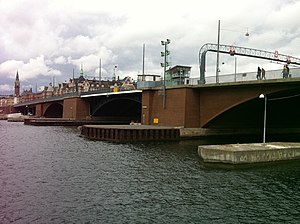Langebro
Coordinates: 55 ° 40 ′ 13 ″ N , 12 ° 34 ′ 44 ″ E
| Langebro | ||
|---|---|---|
| Langebro in May 2011 | ||
| use | six-lane road, bike path, footpath | |
| Crossing of | Inderhavnen , Copenhagen harbor | |
| place | Copenhagen | |
| construction | Bascule bridge / seesaw bridge | |
| overall length | 252 m | |
| width | 32 m | |
| Clear width | 35 m | |
| Headroom | 7 m, bascule bridge | |
| vehicles per day | 62,200 (as of 1998) | |
| start of building | 1949 | |
| completion | 1954 | |
| opening | June 27, 1954 | |
| planner | Københavns Kommune and Københavns Havn (builders), Kaj Gottlob (architect) | |
| location | ||
|
|
||
The Langebro ( German Long Bridge ) is a six-lane road bridge in the center of Copenhagen , which leads over the Inderhavnen (inner harbor) and connects Zealand with Amager . In addition to the Knippelsbro , it represents a main traffic connection between the two Danish islands with over 62,000 vehicles per day (as of 1998) . The 252 meter long and 32 meter wide bridge consists of two folding segments that can be opened for shipping if necessary. However, it is seldom opened - and if so only in the evening - to be considerate of rush hour traffic. In addition, the port activities in the southern harbor (Sydhavn) have shifted to other areas.
history
precursor
The first forerunner was the Kallebobro , a three-meter-wide wooden bridge that was built between 1686 and 1690 at the instigation of the Danish King Christian V. The bridge, which was built for strategic military reasons and connected two bastions on both sides of the port, was given the name Langebro (Long Bridge) over time because it was longer than Knippelsbro , which was further north .
In 1851 a new, wider wooden bridge was built, which was modernized in 1875 with two iron folding segments and again replaced by a new iron bridge in 1903. The 120 meter long, 13 meter wide swing bridge was named Christian the Elder. IX's bro , however, was also popularly called Langebro . Increasing traffic in the 1920s led to the construction of a successor, a combined road and rail bridge, which was completed in 1930 after a year of construction. During the German occupation , the sabotage group BOPA (Borgerlige Partisaner) carried out an explosive attack here at the end of March 1945 to prevent 16 Danish merchant ships from exporting to the German Reich . In the attack, in which several Germans and several Danish machinists were killed, the engine house was destroyed, so that the bridge could only be put into operation again after the end of the war on October 1, 1945.
Today's bridge
Today's Langebro was ceremoniously opened after five years of construction on June 27, 1954 when the flaps closed and 50,000 passers-by crossed the bridge. The work was carried out by the Danish construction company Christiani & Nielsen , a company that failed to build the Munkholmbroen in 1937 . The Københavns Municipality contributed two thirds to the construction costs and the port administration (Københavns Havn) one third .
Illustration of the Langebro in 1748 with the Royal Brewery ( Kongens Bryghus ) in the background
Painting by Christoffer Wilhelm Eckersberg from 1836 ( State Art Museum )
View from the Langebro in northwest direction to the headquarters of Danisco (August 2006)
View from Langebro in south direction to the district of Islands Brygge (August 2007)
See also
Web links
- Literature list about the Langebro at the Danish Road and Bridge Museum (Danish)
Individual evidence
- ↑ a b c Langebro. In: Structurae
- ^ A b Henrik Lange: Facta om Langebro . In Highways.dk , accessed December 16, 2011 (Danish)
- ↑ a b c d e Lars Bugge: Kort og godt om danske broer . 2nd Edition. Aschehoug Dansk Forlag A / S, Copenhagen 2000, ISBN 87-11-16234-1 , Langebro, p. 36 (Danish).
- ↑ The Store Danske : Kaj Gottlob , accessed on December 16, 2011 (Danish)
- ↑ Henrik Lange: Portræt af Langebro ( Memento of the original from December 16, 2011 in the Internet Archive ) Info: The archive link has been inserted automatically and has not yet been checked. Please check the original and archive link according to the instructions and then remove this notice. . In Highways.dk , accessed December 16, 2011 (Danish)
- ↑ a b c d Erik Johannesen: Danmarks broer . 1st edition. Borgens Forlag, Copenhagen-Valby 1994, ISBN 87-418-0153-9 , Langebro, p. 98 ff . (Danish).
- ↑ Erik Johannesen: Danmarks Broer . Munkholmbroen, S. 65 ff .








